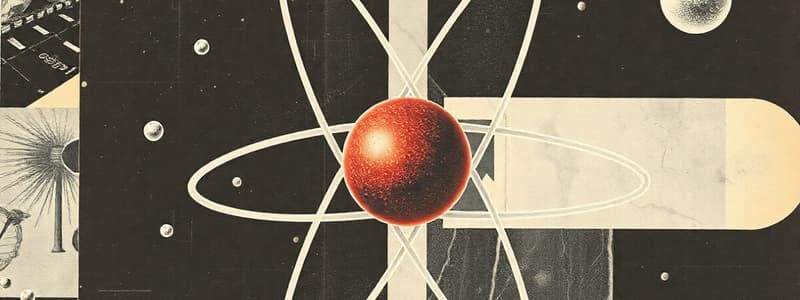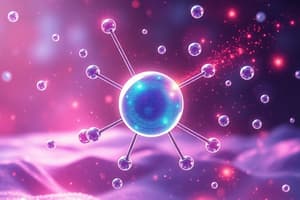Podcast
Questions and Answers
If an atom gains an electron, what type of ion does it become?
If an atom gains an electron, what type of ion does it become?
- An isotope, with an altered atomic mass
- A cation, with a positive charge
- A neutron, with no charge
- An anion, with a negative charge (correct)
Which subatomic particles contribute significantly to the mass of an atom?
Which subatomic particles contribute significantly to the mass of an atom?
- Neutrons and electrons
- Protons only
- Electrons only
- Protons and neutrons (correct)
What distinguishes an element from a chemical compound?
What distinguishes an element from a chemical compound?
- Elements have mass, while compounds do not
- Elements are formed through chemical reactions, whereas compounds are naturally occurring
- Elements cannot be broken down into simpler substances by chemical means, whereas chemical compounds can (correct)
- Elements occupy space, while compounds do not
In a solution, if a substance dissociates into free ions, what is this substance referred to as?
In a solution, if a substance dissociates into free ions, what is this substance referred to as?
Consider a neutral atom that loses two electrons. What is the resulting charge of the ion?
Consider a neutral atom that loses two electrons. What is the resulting charge of the ion?
Flashcards
What is matter?
What is matter?
Anything that has mass and takes up space, existing as a solid, liquid, or gas.
Chemical compound
Chemical compound
A substance formed when elements combine chemically.
Atom
Atom
The smallest unit of an element that retains its chemical properties.
Atomic nucleus
Atomic nucleus
Signup and view all the flashcards
Ions
Ions
Signup and view all the flashcards
Study Notes
- Matter occupies space, has mass, and exists as a solid, liquid, or gas.
- Matter is composed of elements.
- Chemical compounds are combinations of elements.
- Atoms are the smallest particles of an element.
- The atomic nucleus contains protons and neutrons.
- Protons are positively charged particles located in the nucleus.
- Neutrons are particles without charge located in the nucleus.
- Electrons are negatively charged particles.
- Ions are electrically charged atoms, molecules, or particles.
Cations
- Form due to electron loss and have a positive charge (+).
Anions
- Form due to electron gain and have a negative charge (–).
Electrolyte
- Free ions present in a solvent.
Studying That Suits You
Use AI to generate personalized quizzes and flashcards to suit your learning preferences.




